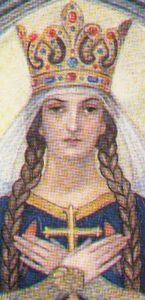
Born: February 18, 1373 (?)
Died: July 17, 1399, Cracow, Poland
Early days. Father Louis of Anjou (Ludwik I Wegierski) King of Poland and of Hungary (Lajos I) and nephew of Casimir III King of Poland (Kazimierz Wielki); mother Elizabieta Kotromanic, Princess of Bosnia and daughter of Elzbieta Kazimierzowna, Princess of Inowroclaw and Gniewkow (Cuyavia = Kujawy).
Jadwiga was betrothed to William of Habsburg. She had to return to Poland when her sister Catherine died in 1378. From the age of eight she lived at the Imperial court in Vienna. Her father had also made an arrangement with the future Holy Roman Emperor Sigismund, for the latter to marry either Jadwiga or her sister Mary of Hungary, later queen of Hungary (Sigismund married Mary.)
Coronation.On October 15, 1384, two years after the death of her father, King of Poland Louis of Anjou, the archbishop of Krakow crowned her as "Jadwiga, King (rex) of Poland" in the cathedral on the Wawel Hill in Cracow.
Marriage to Jagiello. The nobility of Poland prevailed upon her to end her engagement with William and instead to marry Wladyslaw-Jagiello, grand duke of Lithuania, whose country had returned to paganism after a brief period of Christian kingship in the 1250s. For Jadwiga, the experience was extremely painful. She was being told to abandon a young man to whom she has been betrothed since infancy and to wed a pagan bachelor more than three times her age, with whom she could not even converse. She was intelligent, pretty, an accomplished musician and scholar, and entirely helpless. On February 15, 1386 Jagiello converted to Catholicism, and three days later they were married. In March took place their joint coronation (Jagiello was crowned king of Poland as Ladislaus II). Their marriage was said to be a congenial one, and Jagiello was said to have treated her very well and always saw to her wishes as ruler. Still Jadwiga despised the Polish barons and loved the poor.
On March 22, 1399 (in Krakow), Jadwiga gave birth to her daughter, Elizabeth. Elizabeth only lived three weeks and Jadwiga, who had complications from childbirth died on July 17, 1399. During her illness the castle was besieged by peasants and townsfolk bearing gifts of chickens ans lambs and mushrooms for her recovery. In her last days , she supposedly (Davis)thanked God for the victory of the Tartars on the Vorksla over the Polish and Lithuanian barons , for the ‘humbling of their pride’. Jagiello continued to rule Poland as Ladislaus II until his death 35 years later. Jadwiga gave all of her personal jewelry for re-establishing the University of Krakow. She was said to be a blonde, blue-eyed beauty, and an exhumation performed in 1976 showed that she was unusually tall for a medieval woman (1.8m), without physical evidence of any deformity or disability.
Achievements.Beatification.Canonization.Among Jadwiga's accomplishments was the founding of the Bishopric of Wilno (Vilnius). Because of her devotion to the church and a number of miracles recorded throughout her lifetime, she was beatified in 1987. Jadwiga was canonized on June 8, 1997 by Pope John Paul II (the former archbishop of Krakow). Her relics are located in the south aisle of the Wawel Cathedral in Krakow.
This article uses, among others, material from the Wikipedia article "Jadwiga of Poland" licensed under the GNU Free Documentation License. :
Wikipedia
and on other sources:
Norman Davis “History of Poland” Vol.I
Lehigh
WIEM
Catholic Encyclopedia
Poczet Krolow Polskich
Genealogy
Poczet wladcow Polski
Return to home page:
Prominent Poles